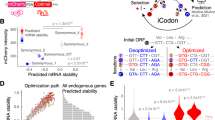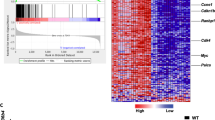Abstract
Codon-usage bias has been observed in almost all genomes and is thought to result from selection for efficient and accurate translation of highly expressed genes1,2,3. Codon usage is also implicated in the control of transcription, splicing and RNA structure4,5,6. Many genes exhibit little codon-usage bias, which is thought to reflect a lack of selection for messenger RNA translation. Alternatively, however, non-optimal codon usage may be of biological importance. The rhythmic expression and the proper function of the Neurospora FREQUENCY (FRQ) protein are essential for circadian clock function. Here we show that, unlike most genes in Neurospora, frq exhibits non-optimal codon usage across its entire open reading frame. Optimization of frq codon usage abolishes both overt and molecular circadian rhythms. Codon optimization not only increases FRQ levels but, unexpectedly, also results in conformational changes in FRQ protein, altered FRQ phosphorylation profile and stability, and impaired functions in the circadian feedback loops. These results indicate that non-optimal codon usage of frq is essential for its circadian clock function. Our study provides an example of how non-optimal codon usage functions to regulate protein expression and to achieve optimal protein structure and function.
This is a preview of subscription content, access via your institution
Access options
Subscribe to this journal
Receive 51 print issues and online access
$199.00 per year
only $3.90 per issue
Buy this article
- Purchase on SpringerLink
- Instant access to full article PDF
Prices may be subject to local taxes which are calculated during checkout




Similar content being viewed by others
References
Ikemura, T. Codon usage and tRNA content in unicellular and multicellular organisms. Mol. Biol. Evol. 2, 13–34 (1985)
Plotkin, J. B. & Kudla, G. Synonymous but not the same: the causes and consequences of codon bias. Nature Rev. Genet. 12, 32–42 (2011)
Drummond, D. A. & Wilke, C. O. Mistranslation-induced protein misfolding as a dominant constraint on coding-sequence evolution. Cell 134, 341–352 (2008)
Tuller, T. et al. An evolutionarily conserved mechanism for controlling the efficiency of protein translation. Cell 141, 344–354 (2010)
Gu, W., Zhou, T. & Wilke, C. O. A universal trend of reduced mRNA stability near the translation-initiation site in prokaryotes and eukaryotes. PLoS Comput. Biol. 6, e1000664 (2010)
Cannarozzi, G. et al. A role for codon order in translation dynamics. Cell 141, 355–367 (2010)
Heintzen, C. & Liu, Y. The Neurospora crassa circadian clock. Adv. Genet. 58, 25–66 (2007)
Baker, C. L., Loros, J. J. & Dunlap, J. C. The circadian clock of Neurospora crassa. FEMS Microbiol. Rev. 36, 95–110 (2012)
Cheng, P., He, Q., He, Q., Wang, L. & Liu, Y. Regulation of the Neurospora circadian clock by an RNA helicase. Genes Dev. 19, 234–241 (2005)
Cheng, P., Yang, Y. & Liu, Y. Interlocked feedback loops contribute to the robustness of the Neurospora circadian clock. Proc. Natl Acad. Sci. USA 98, 7408–7413 (2001)
He, Q. et al. CKI and CKII mediate the FREQUENCY-dependent phosphorylation of the WHITE COLLAR complex to close the Neurospora circadian negative feedback loop. Genes Dev. 20, 2552–2565 (2006)
Schafmeier, T. et al. Transcriptional feedback of Neurospora circadian clock gene by phosphorylation-dependent inactivation of its transcription factor. Cell 122, 235–246 (2005)
Huang, G., Wang, L. & Liu, Y. Molecular mechanism of suppression of circadian rhythms by a critical stimulus. EMBO J. 25, 5349–5357 (2006)
Lee, K., Loros, J. J. & Dunlap, J. C. Interconnected feedback loops in the Neurospora circadian system. Science 289, 107–110 (2000)
Morgan, L. W., Greene, A. V. & Bell-Pedersen, D. Circadian and light-induced expression of luciferase in Neurospora crassa. Fungal Genet. Biol. 38, 327–332 (2003)
Gooch, V. D. et al. Fully codon-optimized luciferase uncovers novel temperature characteristics of the Neurospora clock. Eukaryot. Cell 7, 28–37 (2008)
Spencer, P. S., Siller, E., Anderson, J. F. & Barral, J. M. Silent substitutions predictably alter translation elongation rates and protein folding efficiencies. J. Mol. Biol. 422, 328–335 (2012)
Bennetzen, J. L. & Hall, B. D. Codon selection in yeast. J. Biol. Chem. 257, 3026–3031 (1982)
Colot, H. V., Loros, J. J. & Dunlap, J. C. Temperature-modulated alternative splicing and promoter use in the circadian clock gene frequency. Mol. Biol. Cell 16, 5563–5571 (2005)
Diernfellner, A. et al. Long and short isoforms of Neurospora clock protein FRQ support temperature-compensated circadian rhythms. FEBS Lett. 581, 5759–5764 (2007)
Liu, Y., Merrow, M. M., Loros, J. J. & Dunlap, J. C. How temperature changes reset a circadian oscillator. Science 281, 825–829 (1998)
Liu, Y., Garceau, N., Loros, J. J. & Dunlap, J. C. Thermally regulated translational control mediates an aspect of temperature compensation in the Neurospora circadian clock. Cell 89, 477–486 (1997)
Tang, C. T. et al. Setting the pace of the Neurospora circadian clock by multiple independent FRQ phosphorylation events. Proc. Natl Acad. Sci. USA 106, 10722–10727 (2009)
Baker, C. L., Kettenbach, A. N., Loros, J. J., Gerber, S. A. & Dunlap, J. C. Quantitative proteomics reveals a dynamic interactome and phase-specific phosphorylation in the Neurospora circadian clock. Mol. Cell 34, 354–363 (2009)
Xu, Y., Ma, P., Shah, P., Rokas, A., Liu, Y. & Johnson, C. H. Non-optimal codon usage is a mechanism to achieve circadian clock conditionality. Nature http://dx.doi.org/10.1038/nature11942 (this issue)
Zhou, T., Weems, M. & Wilke, C. O. Translationally optimal codons associate with structurally sensitive sites in proteins. Mol. Biol. Evol. 26, 1571–1580 (2009)
Siller, E., DeZwaan, D. C., Anderson, J. F., Freeman, B. C. & Barral, J. M. Slowing bacterial translation speed enhances eukaryotic protein folding efficiency. J. Mol. Biol. 396, 1310–1318 (2010)
Komar, A. A., Lesnik, T. & Reiss, C. Synonymous codon substitutions affect ribosome traffic and protein folding during in vitro translation. FEBS Lett. 462, 387–391 (1999)
Kimchi-Sarfaty, C. et al. A “silent” polymorphism in the MDR1 gene changes substrate specificity. Science 315, 525–528 (2007)
Johnson, C. H., Stewart, P. L. & Egli, M. The cyanobacterial circadian system: from biophysics to bioevolution. Annu. Rev. Biophys. 40, 143–167 (2011)
Cha, J., Yuan, H. & Liu, Y. Regulation of the activity and cellular localization of the circadian clock protein FRQ. J. Biol. Chem. 286, 11469–11478 (2011)
Aronson, B. D., Johnson, K. A., Loros, J. J. & Dunlap, J. C. Negative feedback defining a circadian clock: autoregulation in the clock gene frequency. Science 263, 1578–1584 (1994)
Wright, F. The ‘effective number of codons’ used in a gene. Gene 87, 23–29 (1990)
Ishihama, Y. et al. Exponentially modified protein abundance index (emPAI) for estimation of absolute protein amount in proteomics by the number of sequenced peptides per protein. Mol. Cell. Proteomics 4, 1265–1272 (2005)
Bell-Pedersen, D., Dunlap, J. C. & Loros, J. J. Distinct cis-acting elements mediate clock, light, and developmental regulation of the Neurospora crassa eas (ccg-2) gene. Mol. Cell. Biol. 16, 513–521 (1996)
Cheng, P., Yang, Y., Heintzen, C. & Liu, Y. Coiled-coil domain mediated FRQ–FRQ interaction is essential for its circadian clock function in Neurospora. EMBO J. 20, 101–108 (2001)
Garceau, N. Y., Liu, Y., Loros, J. J. & Dunlap, J. C. Alternative initiation of translation and time-specific phosphorylation yield multiple forms of the essential clock protein FREQUENCY. Cell 89, 469–476 (1997)
Guo, J., Cheng, P., Yuan, H. & Liu, Y. The exosome regulates circadian gene expression in a posttranscriptional negative feedback loop. Cell 138, 1236–1246 (2009)
Crosthwaite, S. K., Loros, J. J. & Dunlap, J. C. Light-Induced resetting of a circadian clock is mediated by a rapid increase in frequency transcript. Cell 81, 1003–1012 (1995)
Choudhary, S. et al. A double-stranded-RNA response program important for RNA interference efficiency. Mol. Cell. Biol. 27, 3995–4005 (2007)
Acknowledgements
We thank H. Yuan and Q. Ye for technical assistance, J. Dunlap for providing the pfrq-luc-I construct and M. Rosbash for suggesting the temperature experiments. We apologize to those colleagues whose studies we could not cite owing to space limitations. This work was supported by grants from the National Institutes of Health to Y.L. (GM068496 & GM062591) and M.S.S. (GM47498), and from the Welch Foundation (I-1560) to Y.L.
Author information
Authors and Affiliations
Contributions
Y.L., M.Z. and J.G. designed the research. M.Z., J.G., J.C., M.C., S.C. and J.M.B. performed experiments. M.Z., J.G., J.M.B., M.S.S. and Y.L. analysed the results. Y.L. and M.Z. wrote the paper; J.G., J.M.B. and M.S.S. edited and commented on the manuscript.
Corresponding author
Ethics declarations
Competing interests
The authors declare no competing financial interests.
Supplementary information
Supplementary Information
This file contains Supplementary Figures 1-10 and Supplementary Tables 1-3. (PDF 2074 kb)
Rights and permissions
About this article
Cite this article
Zhou, M., Guo, J., Cha, J. et al. Non-optimal codon usage affects expression, structure and function of clock protein FRQ. Nature 495, 111–115 (2013). https://doi.org/10.1038/nature11833
Received:
Accepted:
Published:
Issue Date:
DOI: https://doi.org/10.1038/nature11833



